Hounslow College: Business and the Business Environment Report
VerifiedAdded on 2021/01/02
|21
|6336
|283
Report
AI Summary
This report provides a detailed analysis of McDonald's business environment, covering various aspects of its operations. It begins by explaining different types of organizations, including public, private (specifically McDonald's), and voluntary sectors, along with their purposes and legal structures. The report then examines the interrelationships between organizational functions and how they connect to organizational objectives and structure. It explores the positive and negative impacts of the macro environment on business operations, supported by examples. Furthermore, it conducts an internal and external analysis of McDonald's to identify its strengths and weaknesses, and explains how these factors interrelate with external macro factors. The report utilizes concepts like the PESTLE model and SWOT analysis to provide a comprehensive understanding of the business and its environment.
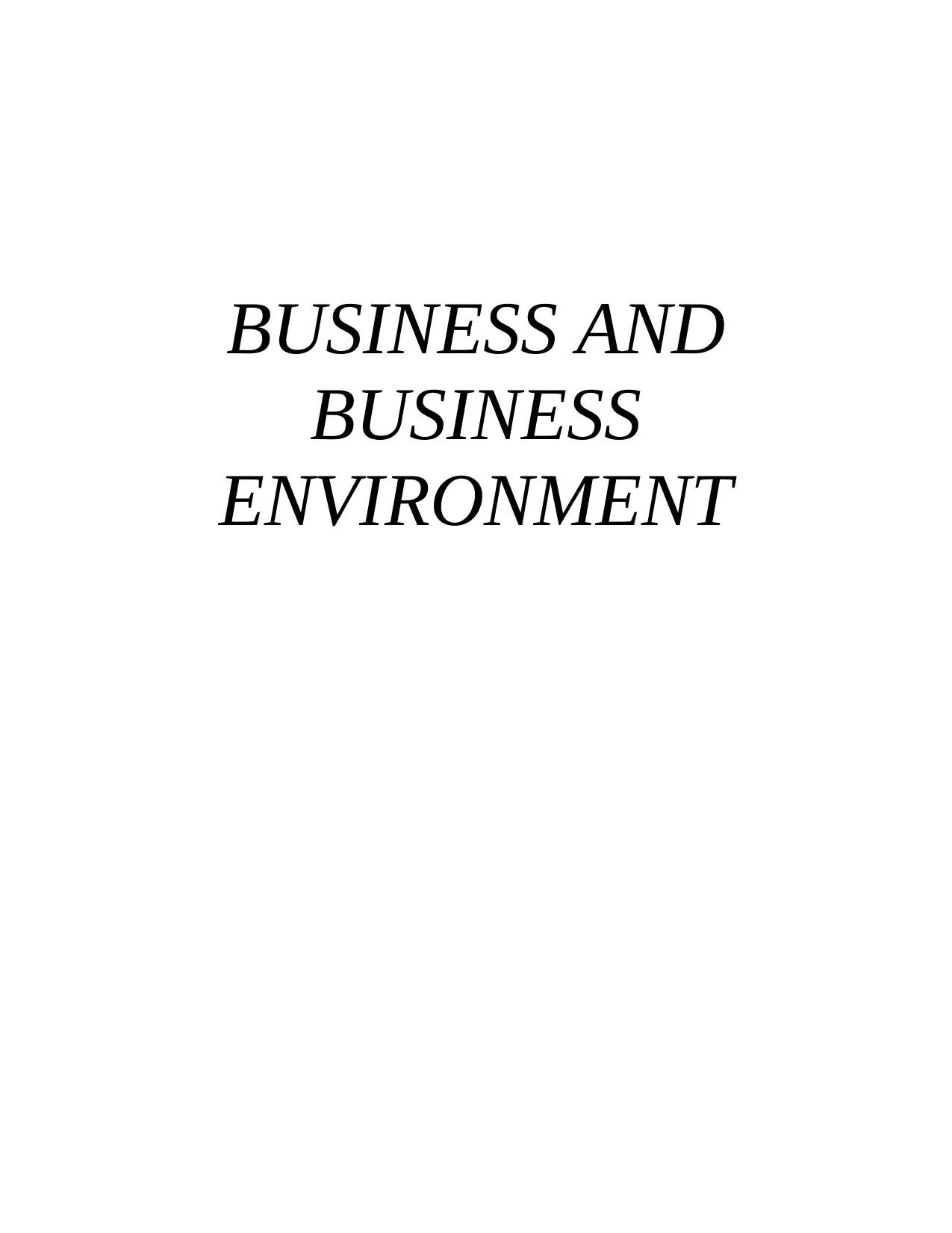
BUSINESS AND
BUSINESS
ENVIRONMENT
BUSINESS
ENVIRONMENT
Paraphrase This Document
Need a fresh take? Get an instant paraphrase of this document with our AI Paraphraser
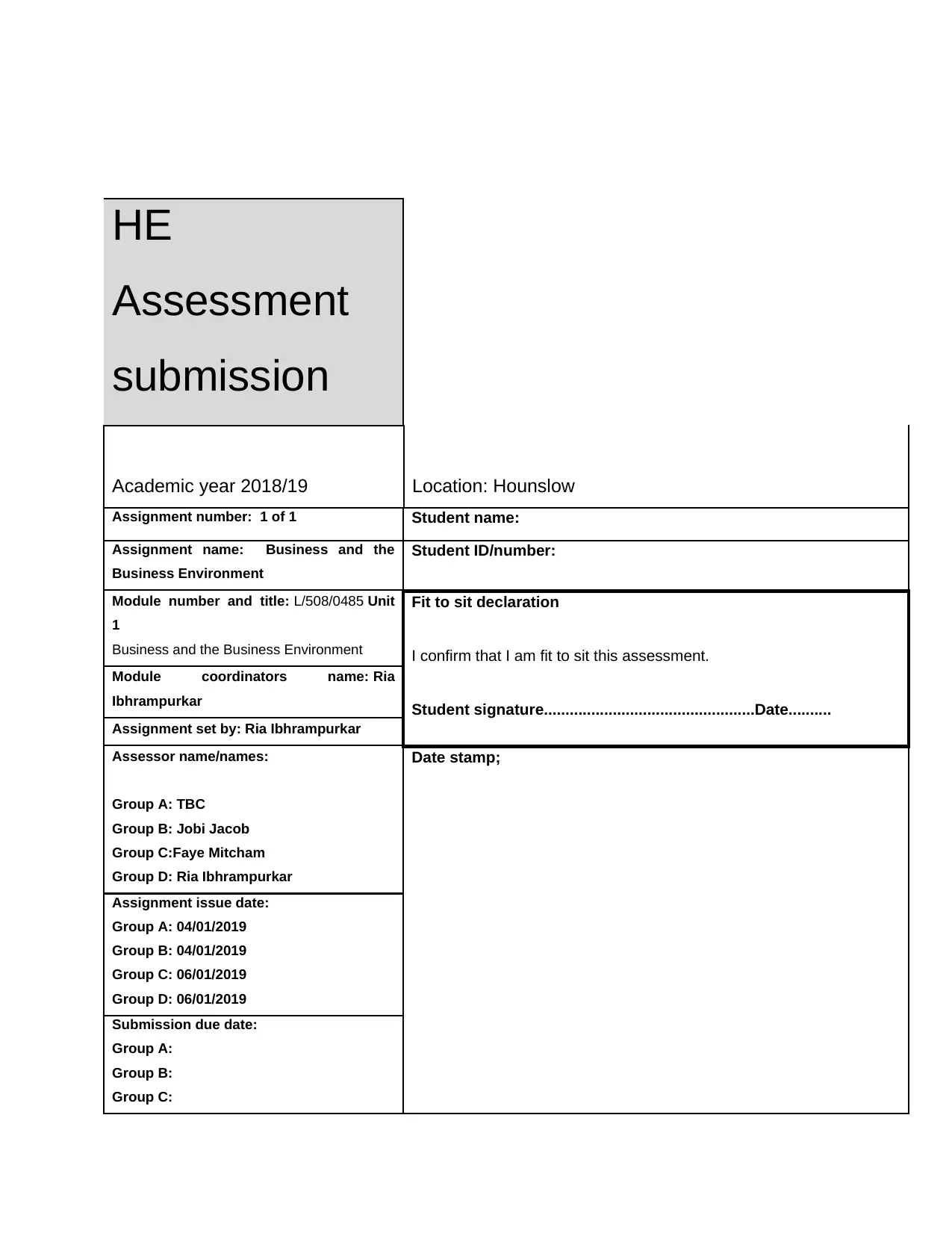
HE
Assessment
submission
Academic year 2018/19 Location: Hounslow
Assignment number: 1 of 1 Student name:
Assignment name: Business and the
Business Environment
Student ID/number:
Module number and title: L/508/0485 Unit
1
Business and the Business Environment
Fit to sit declaration
I confirm that I am fit to sit this assessment.
Student signature.................................................Date..........
Module coordinators name: Ria
Ibhrampurkar
Assignment set by: Ria Ibhrampurkar
Assessor name/names:
Group A: TBC
Group B: Jobi Jacob
Group C:Faye Mitcham
Group D: Ria Ibhrampurkar
Date stamp;
Assignment issue date:
Group A: 04/01/2019
Group B: 04/01/2019
Group C: 06/01/2019
Group D: 06/01/2019
Submission due date:
Group A:
Group B:
Group C:
Assessment
submission
Academic year 2018/19 Location: Hounslow
Assignment number: 1 of 1 Student name:
Assignment name: Business and the
Business Environment
Student ID/number:
Module number and title: L/508/0485 Unit
1
Business and the Business Environment
Fit to sit declaration
I confirm that I am fit to sit this assessment.
Student signature.................................................Date..........
Module coordinators name: Ria
Ibhrampurkar
Assignment set by: Ria Ibhrampurkar
Assessor name/names:
Group A: TBC
Group B: Jobi Jacob
Group C:Faye Mitcham
Group D: Ria Ibhrampurkar
Date stamp;
Assignment issue date:
Group A: 04/01/2019
Group B: 04/01/2019
Group C: 06/01/2019
Group D: 06/01/2019
Submission due date:
Group A:
Group B:
Group C:
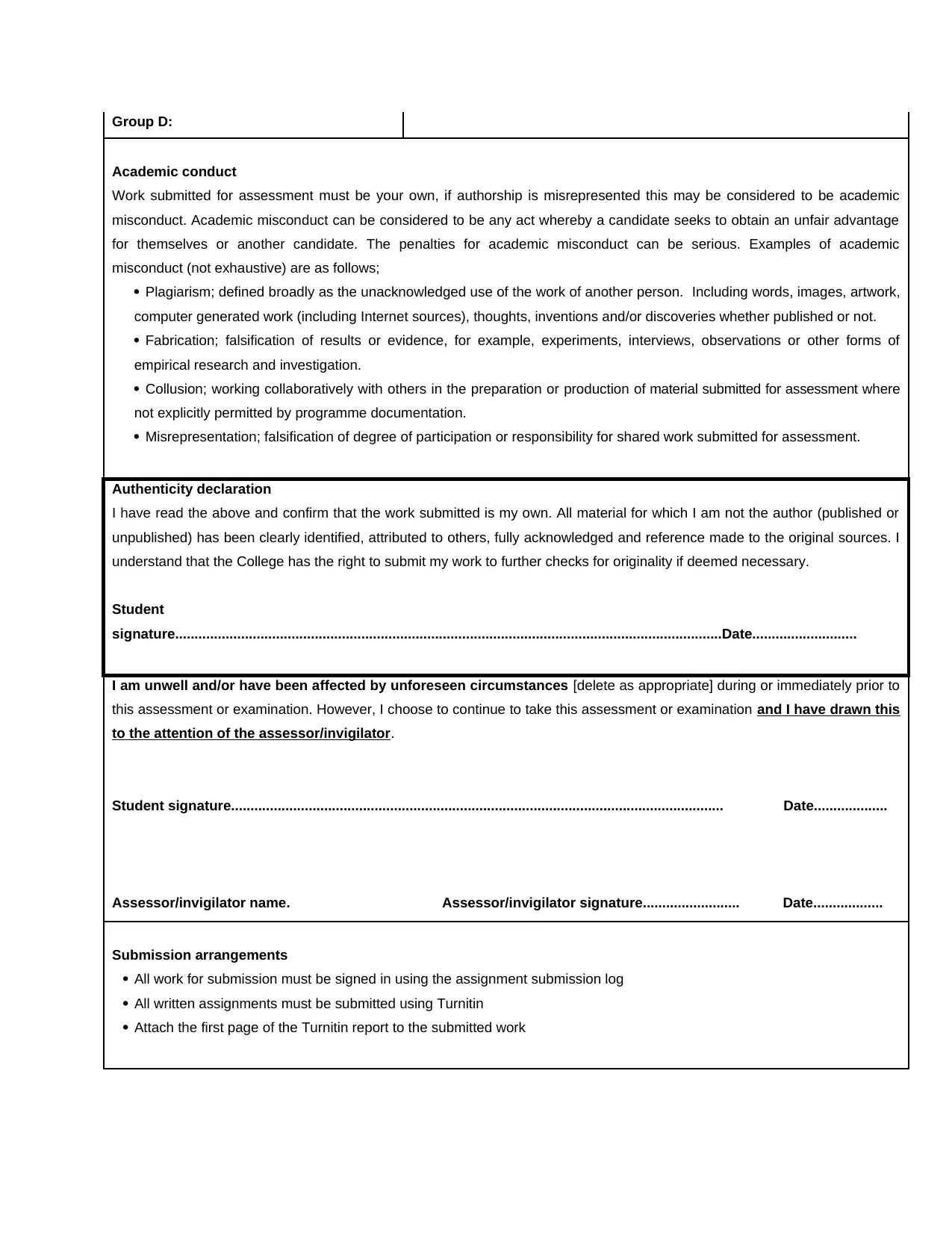
Group D:
Academic conduct
Work submitted for assessment must be your own, if authorship is misrepresented this may be considered to be academic
misconduct. Academic misconduct can be considered to be any act whereby a candidate seeks to obtain an unfair advantage
for themselves or another candidate. The penalties for academic misconduct can be serious. Examples of academic
misconduct (not exhaustive) are as follows;
Plagiarism; defined broadly as the unacknowledged use of the work of another person. Including words, images, artwork,
computer generated work (including Internet sources), thoughts, inventions and/or discoveries whether published or not.
Fabrication; falsification of results or evidence, for example, experiments, interviews, observations or other forms of
empirical research and investigation.
Collusion; working collaboratively with others in the preparation or production of material submitted for assessment where
not explicitly permitted by programme documentation.
Misrepresentation; falsification of degree of participation or responsibility for shared work submitted for assessment.
Authenticity declaration
I have read the above and confirm that the work submitted is my own. All material for which I am not the author (published or
unpublished) has been clearly identified, attributed to others, fully acknowledged and reference made to the original sources. I
understand that the College has the right to submit my work to further checks for originality if deemed necessary.
Student
signature.............................................................................................................................................Date...........................
I am unwell and/or have been affected by unforeseen circumstances [delete as appropriate] during or immediately prior to
this assessment or examination. However, I choose to continue to take this assessment or examination and I have drawn this
to the attention of the assessor/invigilator.
Student signature............................................................................................................................... Date...................
Assessor/invigilator name. Assessor/invigilator signature......................... Date..................
Submission arrangements
All work for submission must be signed in using the assignment submission log
All written assignments must be submitted using Turnitin
Attach the first page of the Turnitin report to the submitted work
Academic conduct
Work submitted for assessment must be your own, if authorship is misrepresented this may be considered to be academic
misconduct. Academic misconduct can be considered to be any act whereby a candidate seeks to obtain an unfair advantage
for themselves or another candidate. The penalties for academic misconduct can be serious. Examples of academic
misconduct (not exhaustive) are as follows;
Plagiarism; defined broadly as the unacknowledged use of the work of another person. Including words, images, artwork,
computer generated work (including Internet sources), thoughts, inventions and/or discoveries whether published or not.
Fabrication; falsification of results or evidence, for example, experiments, interviews, observations or other forms of
empirical research and investigation.
Collusion; working collaboratively with others in the preparation or production of material submitted for assessment where
not explicitly permitted by programme documentation.
Misrepresentation; falsification of degree of participation or responsibility for shared work submitted for assessment.
Authenticity declaration
I have read the above and confirm that the work submitted is my own. All material for which I am not the author (published or
unpublished) has been clearly identified, attributed to others, fully acknowledged and reference made to the original sources. I
understand that the College has the right to submit my work to further checks for originality if deemed necessary.
Student
signature.............................................................................................................................................Date...........................
I am unwell and/or have been affected by unforeseen circumstances [delete as appropriate] during or immediately prior to
this assessment or examination. However, I choose to continue to take this assessment or examination and I have drawn this
to the attention of the assessor/invigilator.
Student signature............................................................................................................................... Date...................
Assessor/invigilator name. Assessor/invigilator signature......................... Date..................
Submission arrangements
All work for submission must be signed in using the assignment submission log
All written assignments must be submitted using Turnitin
Attach the first page of the Turnitin report to the submitted work
⊘ This is a preview!⊘
Do you want full access?
Subscribe today to unlock all pages.

Trusted by 1+ million students worldwide
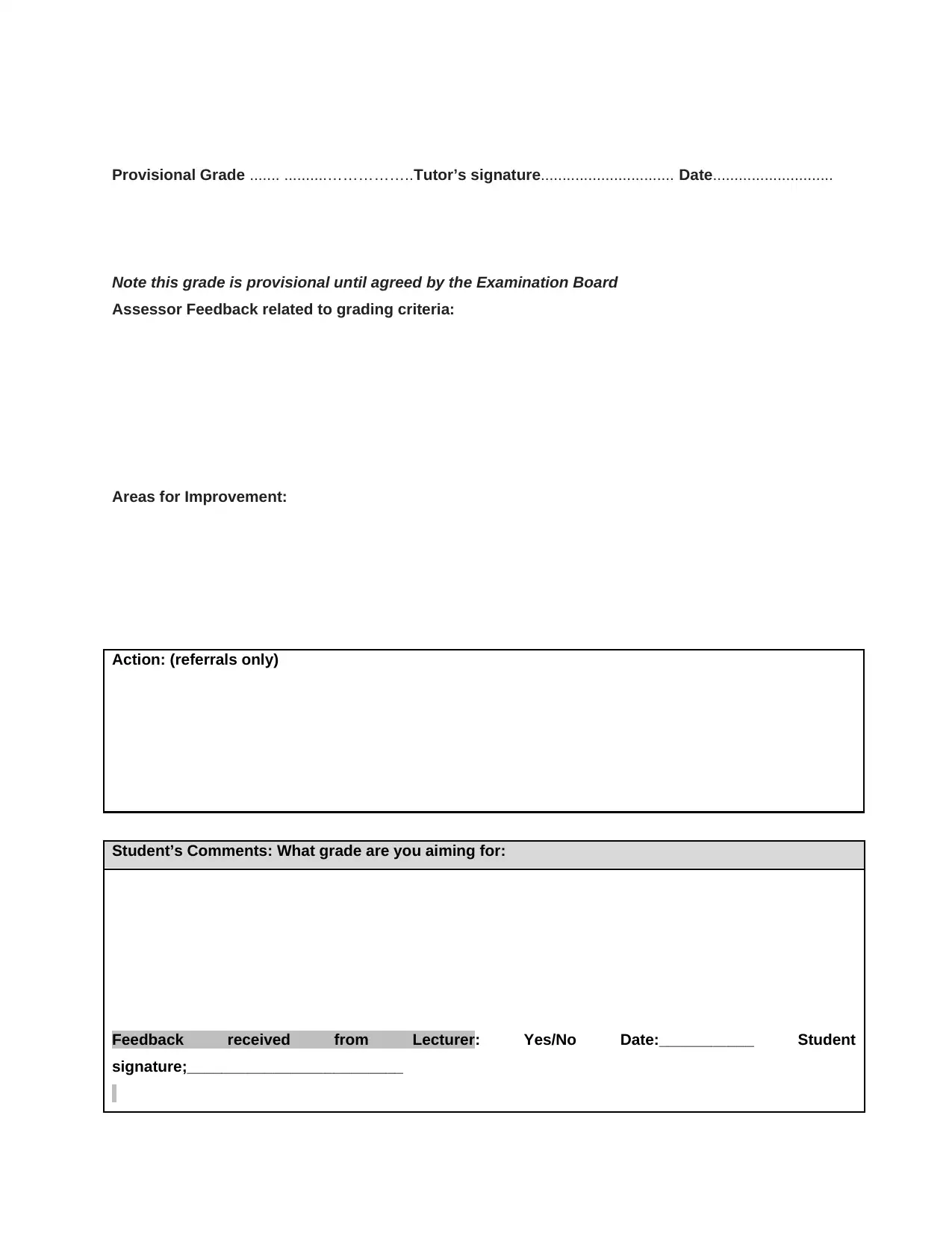
Provisional Grade ....... ..........……………..Tutor’s signature............................... Date............................
Note this grade is provisional until agreed by the Examination Board
Assessor Feedback related to grading criteria:
Areas for Improvement:
Action: (referrals only)
Student’s Comments: What grade are you aiming for:
Feedback received from Lecturer: Yes/No Date:___________ Student
signature;_________________________
Note this grade is provisional until agreed by the Examination Board
Assessor Feedback related to grading criteria:
Areas for Improvement:
Action: (referrals only)
Student’s Comments: What grade are you aiming for:
Feedback received from Lecturer: Yes/No Date:___________ Student
signature;_________________________
Paraphrase This Document
Need a fresh take? Get an instant paraphrase of this document with our AI Paraphraser
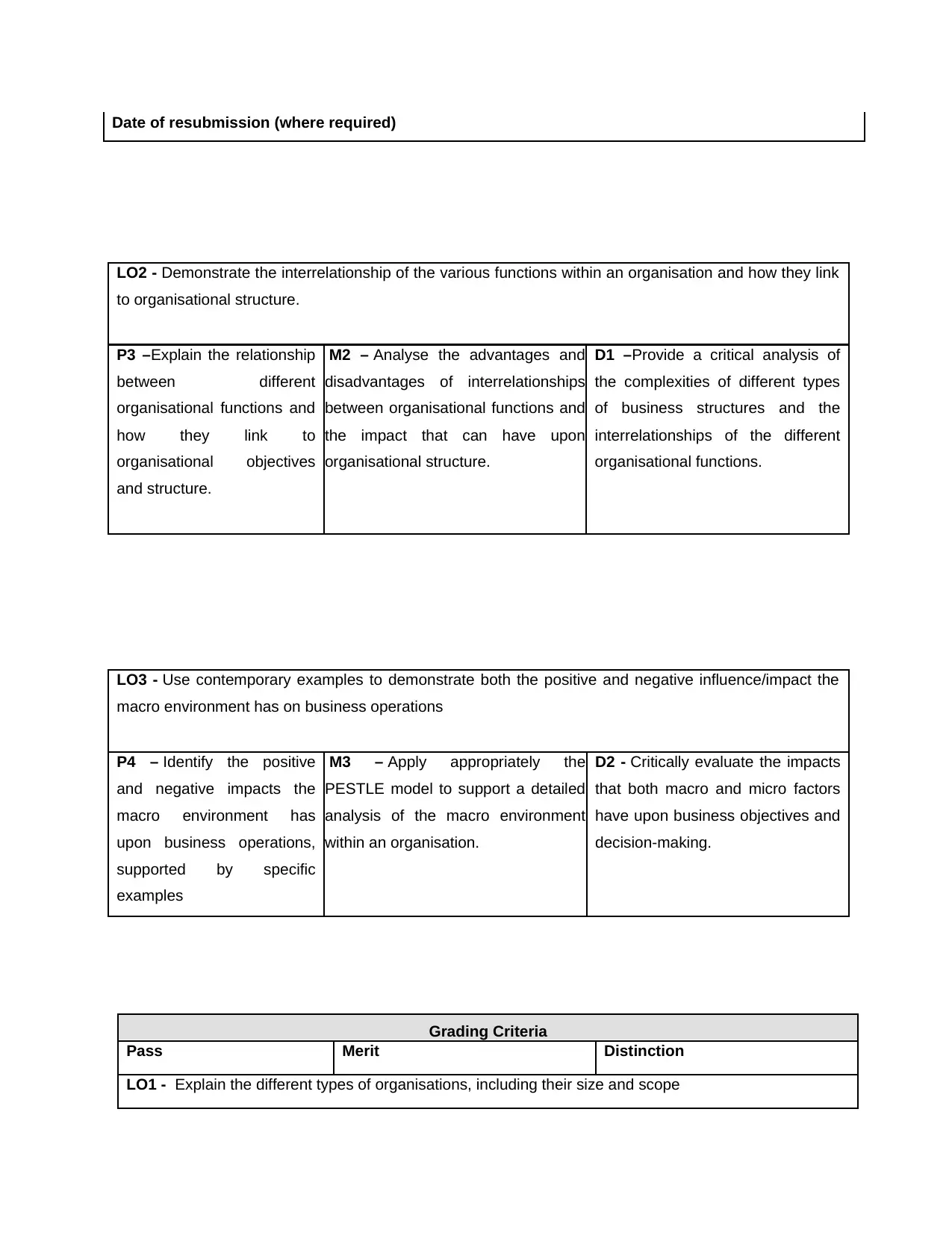
Date of resubmission (where required)
Grading Criteria
Pass Merit Distinction
LO1 - Explain the different types of organisations, including their size and scope
LO2 - Demonstrate the interrelationship of the various functions within an organisation and how they link
to organisational structure.
P3 –Explain the relationship
between different
organisational functions and
how they link to
organisational objectives
and structure.
M2 – Analyse the advantages and
disadvantages of interrelationships
between organisational functions and
the impact that can have upon
organisational structure.
D1 –Provide a critical analysis of
the complexities of different types
of business structures and the
interrelationships of the different
organisational functions.
LO3 - Use contemporary examples to demonstrate both the positive and negative influence/impact the
macro environment has on business operations
P4 – Identify the positive
and negative impacts the
macro environment has
upon business operations,
supported by specific
examples
M3 – Apply appropriately the
PESTLE model to support a detailed
analysis of the macro environment
within an organisation.
D2 - Critically evaluate the impacts
that both macro and micro factors
have upon business objectives and
decision-making.
Grading Criteria
Pass Merit Distinction
LO1 - Explain the different types of organisations, including their size and scope
LO2 - Demonstrate the interrelationship of the various functions within an organisation and how they link
to organisational structure.
P3 –Explain the relationship
between different
organisational functions and
how they link to
organisational objectives
and structure.
M2 – Analyse the advantages and
disadvantages of interrelationships
between organisational functions and
the impact that can have upon
organisational structure.
D1 –Provide a critical analysis of
the complexities of different types
of business structures and the
interrelationships of the different
organisational functions.
LO3 - Use contemporary examples to demonstrate both the positive and negative influence/impact the
macro environment has on business operations
P4 – Identify the positive
and negative impacts the
macro environment has
upon business operations,
supported by specific
examples
M3 – Apply appropriately the
PESTLE model to support a detailed
analysis of the macro environment
within an organisation.
D2 - Critically evaluate the impacts
that both macro and micro factors
have upon business objectives and
decision-making.
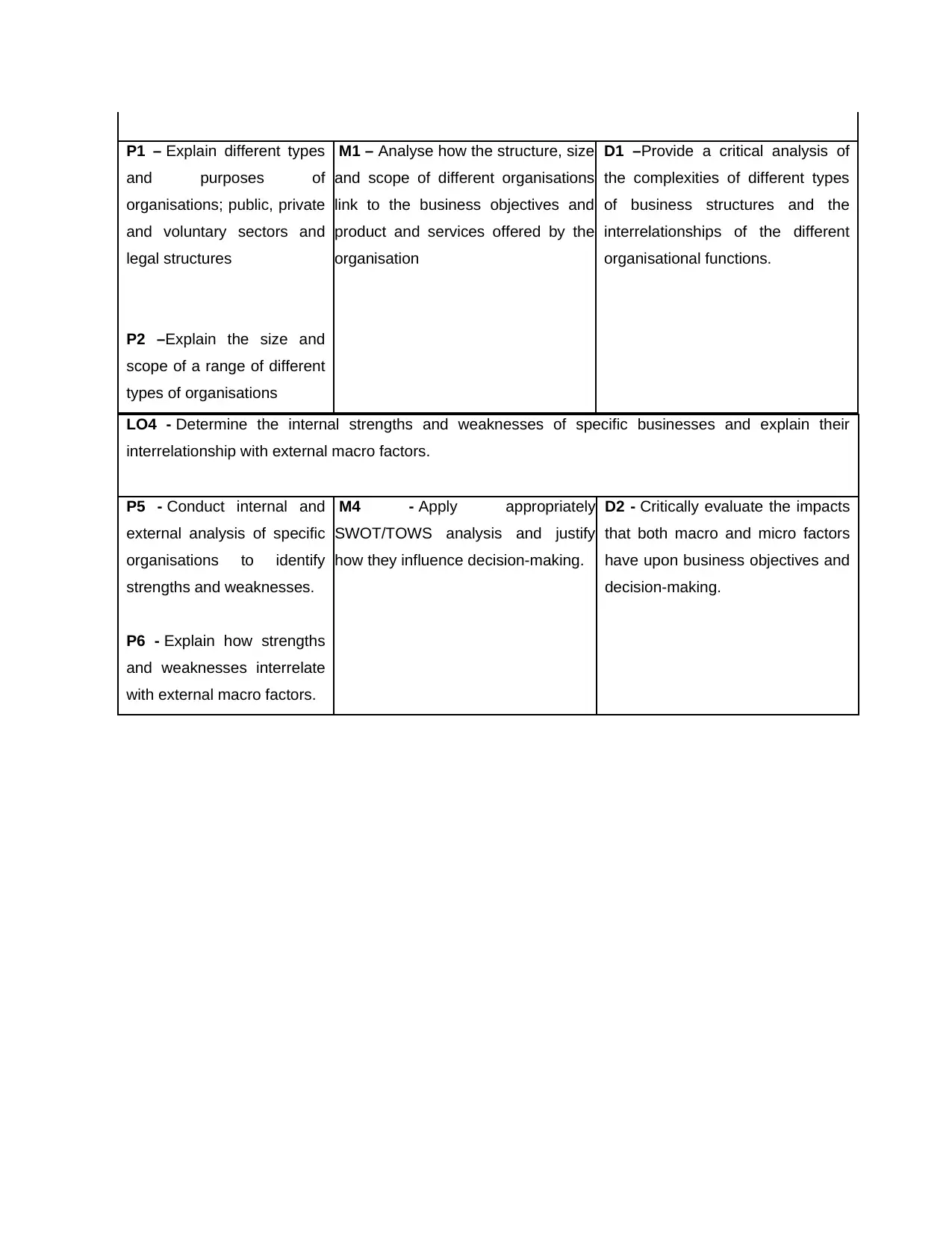
P1 – Explain different types
and purposes of
organisations; public, private
and voluntary sectors and
legal structures
P2 –Explain the size and
scope of a range of different
types of organisations
M1 – Analyse how the structure, size
and scope of different organisations
link to the business objectives and
product and services offered by the
organisation
D1 –Provide a critical analysis of
the complexities of different types
of business structures and the
interrelationships of the different
organisational functions.
LO4 - Determine the internal strengths and weaknesses of specific businesses and explain their
interrelationship with external macro factors.
P5 - Conduct internal and
external analysis of specific
organisations to identify
strengths and weaknesses.
P6 - Explain how strengths
and weaknesses interrelate
with external macro factors.
M4 - Apply appropriately
SWOT/TOWS analysis and justify
how they influence decision-making.
D2 - Critically evaluate the impacts
that both macro and micro factors
have upon business objectives and
decision-making.
and purposes of
organisations; public, private
and voluntary sectors and
legal structures
P2 –Explain the size and
scope of a range of different
types of organisations
M1 – Analyse how the structure, size
and scope of different organisations
link to the business objectives and
product and services offered by the
organisation
D1 –Provide a critical analysis of
the complexities of different types
of business structures and the
interrelationships of the different
organisational functions.
LO4 - Determine the internal strengths and weaknesses of specific businesses and explain their
interrelationship with external macro factors.
P5 - Conduct internal and
external analysis of specific
organisations to identify
strengths and weaknesses.
P6 - Explain how strengths
and weaknesses interrelate
with external macro factors.
M4 - Apply appropriately
SWOT/TOWS analysis and justify
how they influence decision-making.
D2 - Critically evaluate the impacts
that both macro and micro factors
have upon business objectives and
decision-making.
⊘ This is a preview!⊘
Do you want full access?
Subscribe today to unlock all pages.

Trusted by 1+ million students worldwide
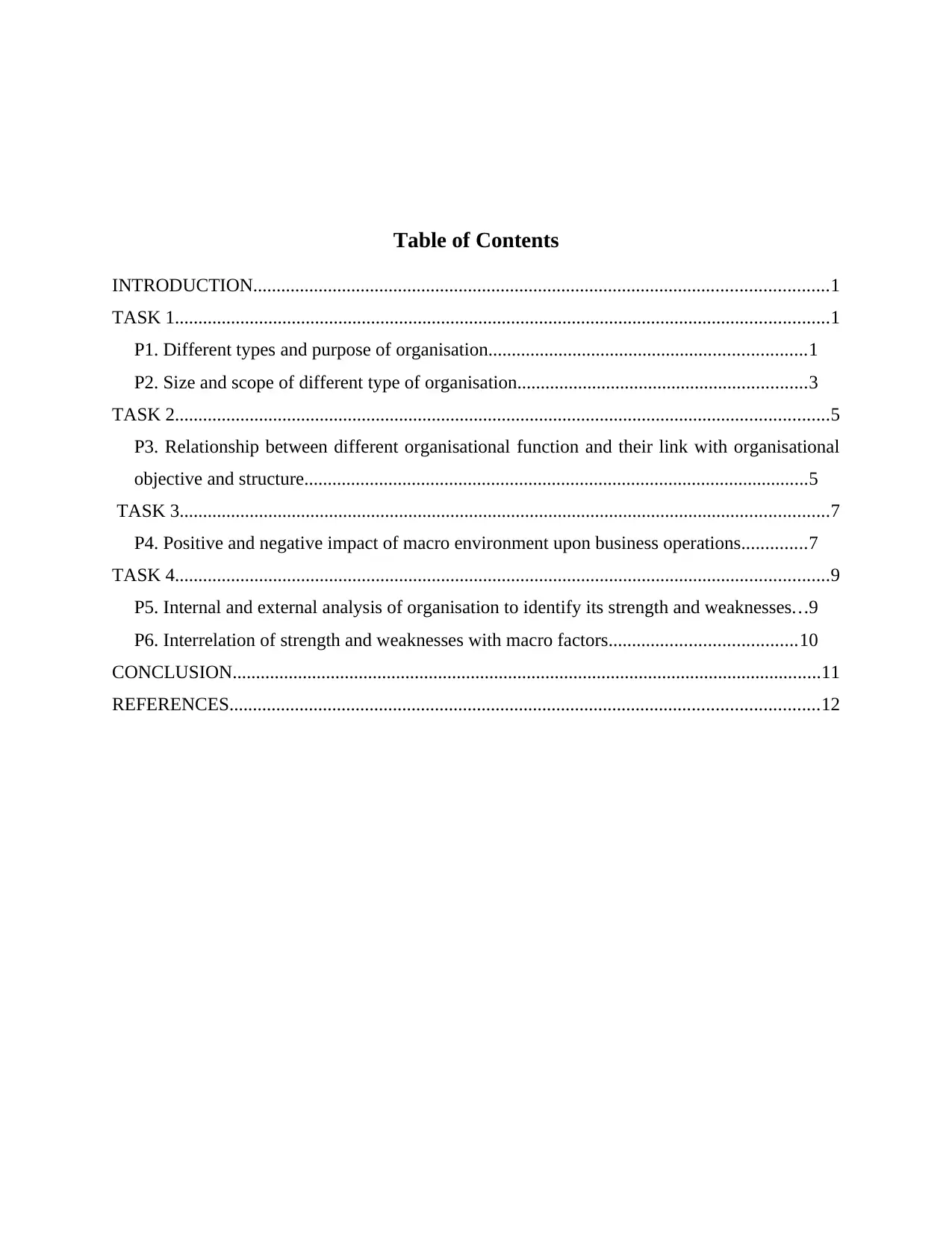
Table of Contents
INTRODUCTION...........................................................................................................................1
TASK 1............................................................................................................................................1
P1. Different types and purpose of organisation....................................................................1
P2. Size and scope of different type of organisation..............................................................3
TASK 2............................................................................................................................................5
P3. Relationship between different organisational function and their link with organisational
objective and structure............................................................................................................5
TASK 3...........................................................................................................................................7
P4. Positive and negative impact of macro environment upon business operations..............7
TASK 4............................................................................................................................................9
P5. Internal and external analysis of organisation to identify its strength and weaknesses...9
P6. Interrelation of strength and weaknesses with macro factors........................................10
CONCLUSION..............................................................................................................................11
REFERENCES..............................................................................................................................12
INTRODUCTION...........................................................................................................................1
TASK 1............................................................................................................................................1
P1. Different types and purpose of organisation....................................................................1
P2. Size and scope of different type of organisation..............................................................3
TASK 2............................................................................................................................................5
P3. Relationship between different organisational function and their link with organisational
objective and structure............................................................................................................5
TASK 3...........................................................................................................................................7
P4. Positive and negative impact of macro environment upon business operations..............7
TASK 4............................................................................................................................................9
P5. Internal and external analysis of organisation to identify its strength and weaknesses...9
P6. Interrelation of strength and weaknesses with macro factors........................................10
CONCLUSION..............................................................................................................................11
REFERENCES..............................................................................................................................12
Paraphrase This Document
Need a fresh take? Get an instant paraphrase of this document with our AI Paraphraser

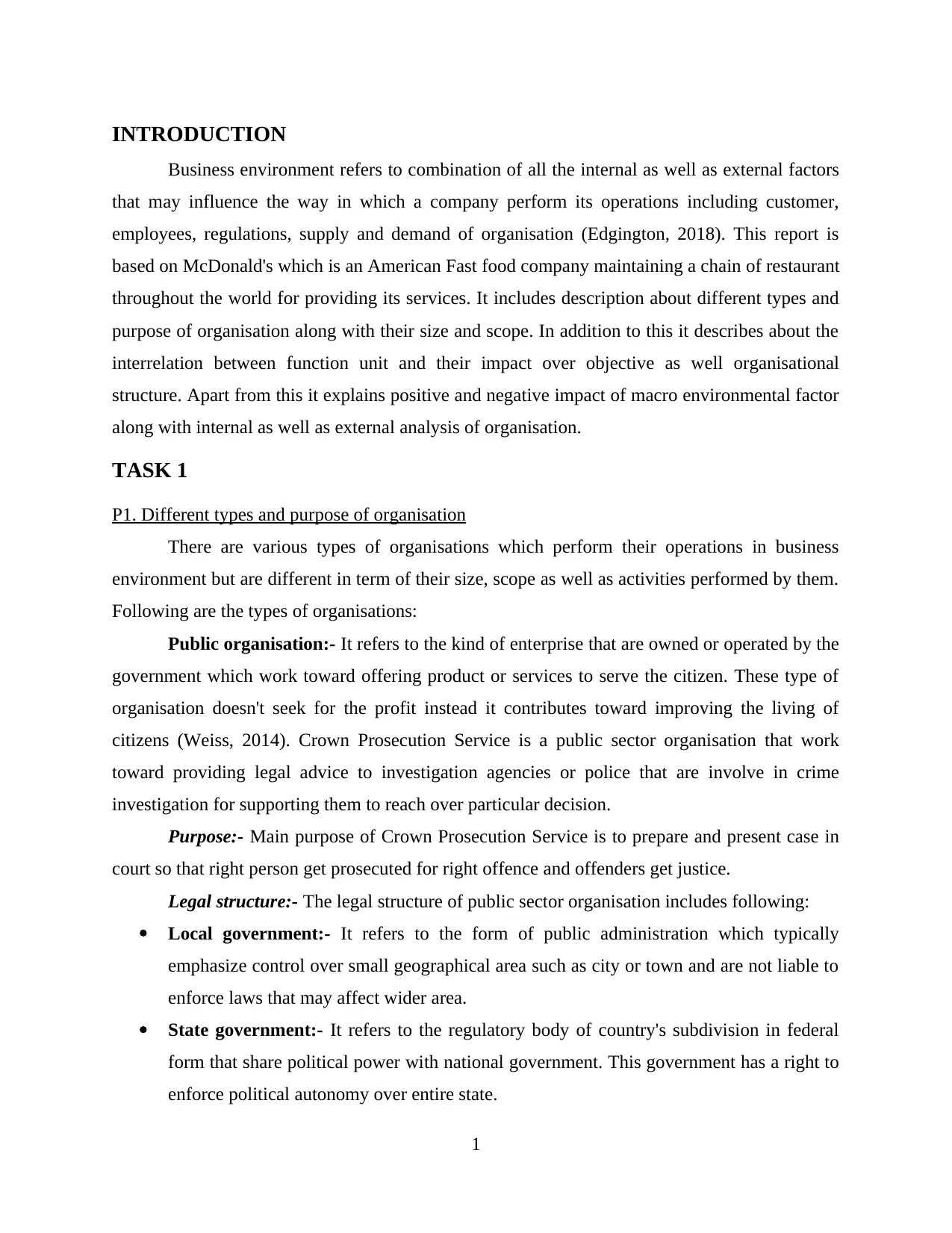
INTRODUCTION
Business environment refers to combination of all the internal as well as external factors
that may influence the way in which a company perform its operations including customer,
employees, regulations, supply and demand of organisation (Edgington, 2018). This report is
based on McDonald's which is an American Fast food company maintaining a chain of restaurant
throughout the world for providing its services. It includes description about different types and
purpose of organisation along with their size and scope. In addition to this it describes about the
interrelation between function unit and their impact over objective as well organisational
structure. Apart from this it explains positive and negative impact of macro environmental factor
along with internal as well as external analysis of organisation.
TASK 1
P1. Different types and purpose of organisation
There are various types of organisations which perform their operations in business
environment but are different in term of their size, scope as well as activities performed by them.
Following are the types of organisations:
Public organisation:- It refers to the kind of enterprise that are owned or operated by the
government which work toward offering product or services to serve the citizen. These type of
organisation doesn't seek for the profit instead it contributes toward improving the living of
citizens (Weiss, 2014). Crown Prosecution Service is a public sector organisation that work
toward providing legal advice to investigation agencies or police that are involve in crime
investigation for supporting them to reach over particular decision.
Purpose:- Main purpose of Crown Prosecution Service is to prepare and present case in
court so that right person get prosecuted for right offence and offenders get justice.
Legal structure:- The legal structure of public sector organisation includes following:
Local government:- It refers to the form of public administration which typically
emphasize control over small geographical area such as city or town and are not liable to
enforce laws that may affect wider area.
State government:- It refers to the regulatory body of country's subdivision in federal
form that share political power with national government. This government has a right to
enforce political autonomy over entire state.
1
Business environment refers to combination of all the internal as well as external factors
that may influence the way in which a company perform its operations including customer,
employees, regulations, supply and demand of organisation (Edgington, 2018). This report is
based on McDonald's which is an American Fast food company maintaining a chain of restaurant
throughout the world for providing its services. It includes description about different types and
purpose of organisation along with their size and scope. In addition to this it describes about the
interrelation between function unit and their impact over objective as well organisational
structure. Apart from this it explains positive and negative impact of macro environmental factor
along with internal as well as external analysis of organisation.
TASK 1
P1. Different types and purpose of organisation
There are various types of organisations which perform their operations in business
environment but are different in term of their size, scope as well as activities performed by them.
Following are the types of organisations:
Public organisation:- It refers to the kind of enterprise that are owned or operated by the
government which work toward offering product or services to serve the citizen. These type of
organisation doesn't seek for the profit instead it contributes toward improving the living of
citizens (Weiss, 2014). Crown Prosecution Service is a public sector organisation that work
toward providing legal advice to investigation agencies or police that are involve in crime
investigation for supporting them to reach over particular decision.
Purpose:- Main purpose of Crown Prosecution Service is to prepare and present case in
court so that right person get prosecuted for right offence and offenders get justice.
Legal structure:- The legal structure of public sector organisation includes following:
Local government:- It refers to the form of public administration which typically
emphasize control over small geographical area such as city or town and are not liable to
enforce laws that may affect wider area.
State government:- It refers to the regulatory body of country's subdivision in federal
form that share political power with national government. This government has a right to
enforce political autonomy over entire state.
1
⊘ This is a preview!⊘
Do you want full access?
Subscribe today to unlock all pages.

Trusted by 1+ million students worldwide
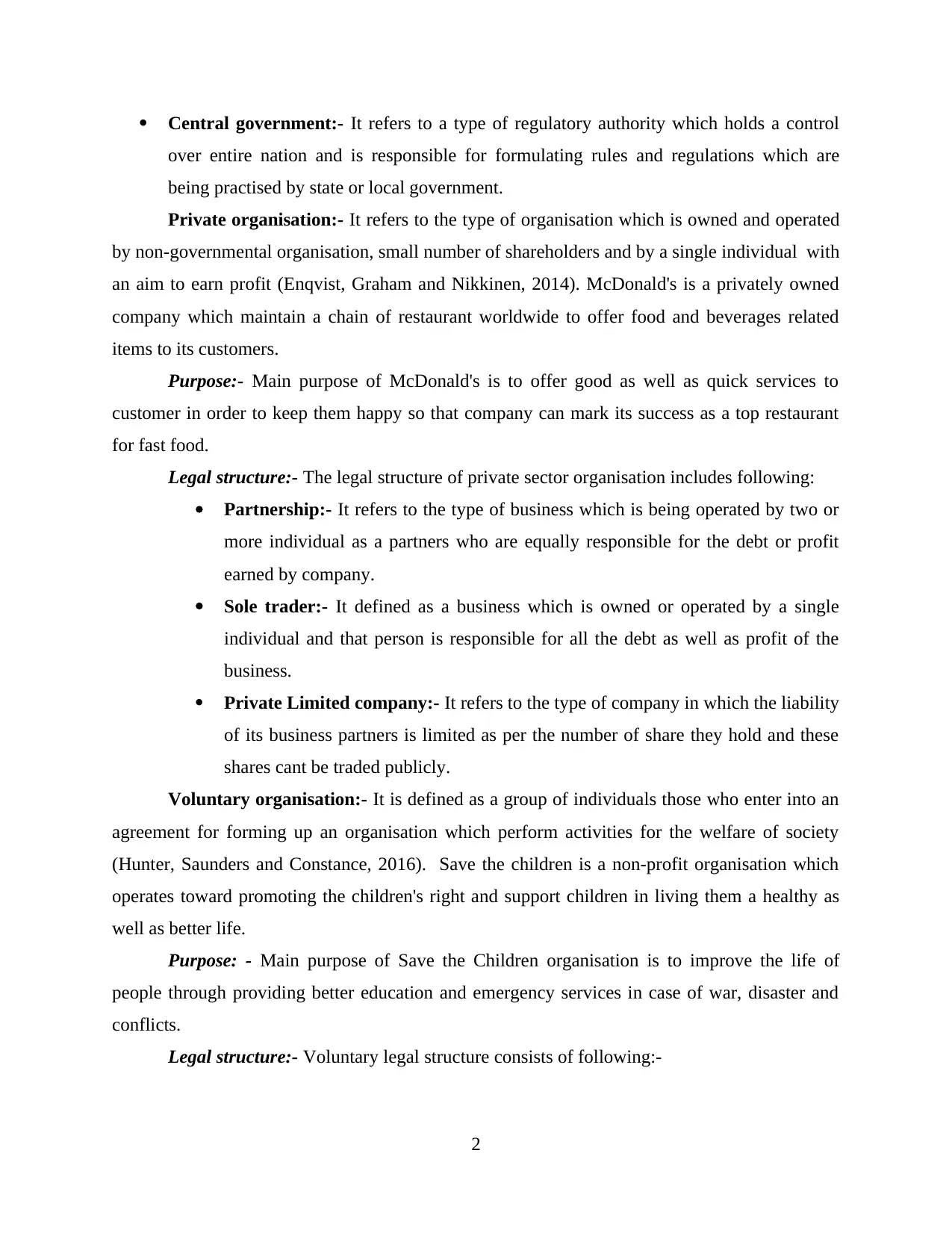
Central government:- It refers to a type of regulatory authority which holds a control
over entire nation and is responsible for formulating rules and regulations which are
being practised by state or local government.
Private organisation:- It refers to the type of organisation which is owned and operated
by non-governmental organisation, small number of shareholders and by a single individual with
an aim to earn profit (Enqvist, Graham and Nikkinen, 2014). McDonald's is a privately owned
company which maintain a chain of restaurant worldwide to offer food and beverages related
items to its customers.
Purpose:- Main purpose of McDonald's is to offer good as well as quick services to
customer in order to keep them happy so that company can mark its success as a top restaurant
for fast food.
Legal structure:- The legal structure of private sector organisation includes following:
Partnership:- It refers to the type of business which is being operated by two or
more individual as a partners who are equally responsible for the debt or profit
earned by company.
Sole trader:- It defined as a business which is owned or operated by a single
individual and that person is responsible for all the debt as well as profit of the
business.
Private Limited company:- It refers to the type of company in which the liability
of its business partners is limited as per the number of share they hold and these
shares cant be traded publicly.
Voluntary organisation:- It is defined as a group of individuals those who enter into an
agreement for forming up an organisation which perform activities for the welfare of society
(Hunter, Saunders and Constance, 2016). Save the children is a non-profit organisation which
operates toward promoting the children's right and support children in living them a healthy as
well as better life.
Purpose: - Main purpose of Save the Children organisation is to improve the life of
people through providing better education and emergency services in case of war, disaster and
conflicts.
Legal structure:- Voluntary legal structure consists of following:-
2
over entire nation and is responsible for formulating rules and regulations which are
being practised by state or local government.
Private organisation:- It refers to the type of organisation which is owned and operated
by non-governmental organisation, small number of shareholders and by a single individual with
an aim to earn profit (Enqvist, Graham and Nikkinen, 2014). McDonald's is a privately owned
company which maintain a chain of restaurant worldwide to offer food and beverages related
items to its customers.
Purpose:- Main purpose of McDonald's is to offer good as well as quick services to
customer in order to keep them happy so that company can mark its success as a top restaurant
for fast food.
Legal structure:- The legal structure of private sector organisation includes following:
Partnership:- It refers to the type of business which is being operated by two or
more individual as a partners who are equally responsible for the debt or profit
earned by company.
Sole trader:- It defined as a business which is owned or operated by a single
individual and that person is responsible for all the debt as well as profit of the
business.
Private Limited company:- It refers to the type of company in which the liability
of its business partners is limited as per the number of share they hold and these
shares cant be traded publicly.
Voluntary organisation:- It is defined as a group of individuals those who enter into an
agreement for forming up an organisation which perform activities for the welfare of society
(Hunter, Saunders and Constance, 2016). Save the children is a non-profit organisation which
operates toward promoting the children's right and support children in living them a healthy as
well as better life.
Purpose: - Main purpose of Save the Children organisation is to improve the life of
people through providing better education and emergency services in case of war, disaster and
conflicts.
Legal structure:- Voluntary legal structure consists of following:-
2
Paraphrase This Document
Need a fresh take? Get an instant paraphrase of this document with our AI Paraphraser
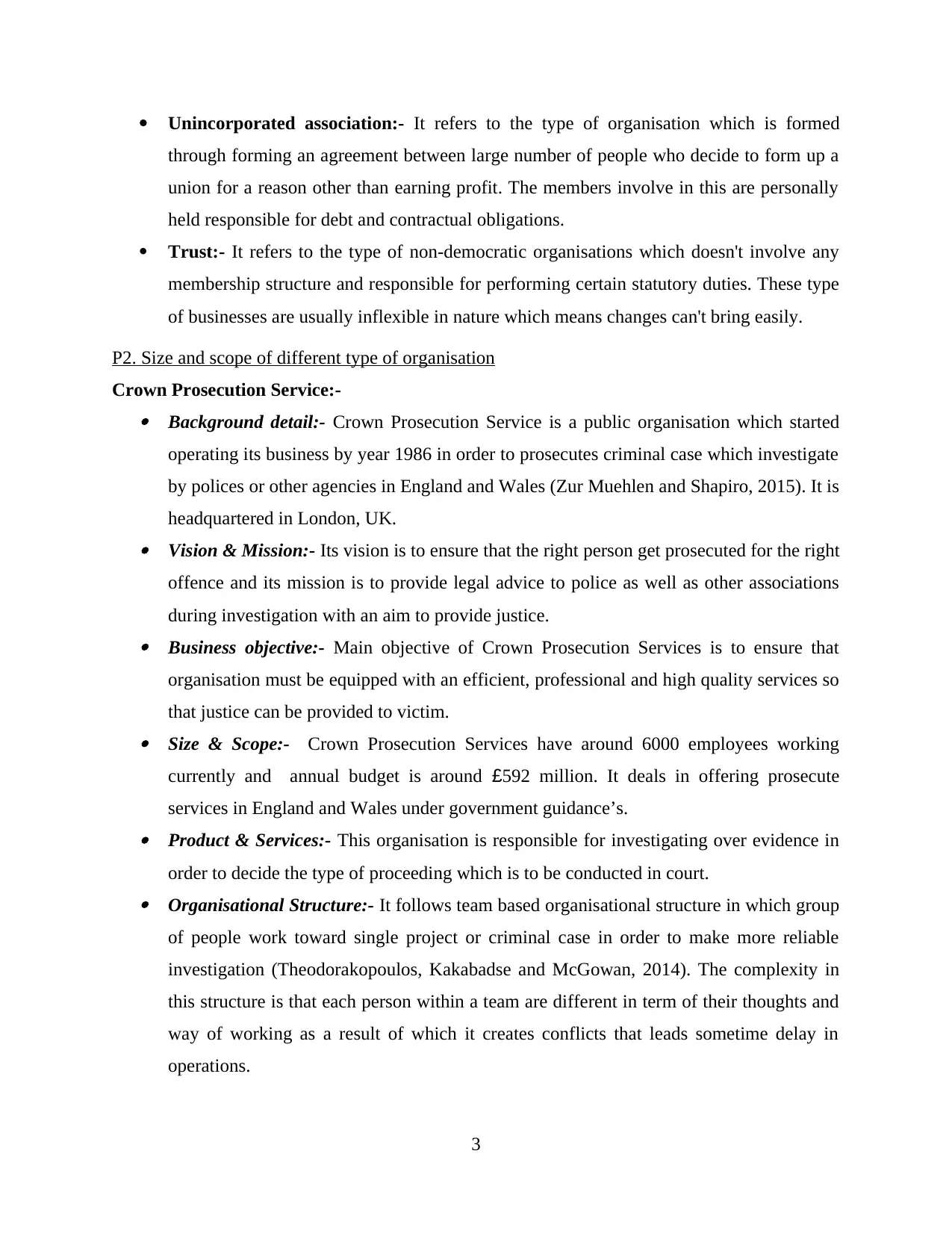
Unincorporated association:- It refers to the type of organisation which is formed
through forming an agreement between large number of people who decide to form up a
union for a reason other than earning profit. The members involve in this are personally
held responsible for debt and contractual obligations.
Trust:- It refers to the type of non-democratic organisations which doesn't involve any
membership structure and responsible for performing certain statutory duties. These type
of businesses are usually inflexible in nature which means changes can't bring easily.
P2. Size and scope of different type of organisation
Crown Prosecution Service:- Background detail:- Crown Prosecution Service is a public organisation which started
operating its business by year 1986 in order to prosecutes criminal case which investigate
by polices or other agencies in England and Wales (Zur Muehlen and Shapiro, 2015). It is
headquartered in London, UK. Vision & Mission:- Its vision is to ensure that the right person get prosecuted for the right
offence and its mission is to provide legal advice to police as well as other associations
during investigation with an aim to provide justice. Business objective:- Main objective of Crown Prosecution Services is to ensure that
organisation must be equipped with an efficient, professional and high quality services so
that justice can be provided to victim. Size & Scope:- Crown Prosecution Services have around 6000 employees working
currently and annual budget is around £592 million. It deals in offering prosecute
services in England and Wales under government guidance’s. Product & Services:- This organisation is responsible for investigating over evidence in
order to decide the type of proceeding which is to be conducted in court. Organisational Structure:- It follows team based organisational structure in which group
of people work toward single project or criminal case in order to make more reliable
investigation (Theodorakopoulos, Kakabadse and McGowan, 2014). The complexity in
this structure is that each person within a team are different in term of their thoughts and
way of working as a result of which it creates conflicts that leads sometime delay in
operations.
3
through forming an agreement between large number of people who decide to form up a
union for a reason other than earning profit. The members involve in this are personally
held responsible for debt and contractual obligations.
Trust:- It refers to the type of non-democratic organisations which doesn't involve any
membership structure and responsible for performing certain statutory duties. These type
of businesses are usually inflexible in nature which means changes can't bring easily.
P2. Size and scope of different type of organisation
Crown Prosecution Service:- Background detail:- Crown Prosecution Service is a public organisation which started
operating its business by year 1986 in order to prosecutes criminal case which investigate
by polices or other agencies in England and Wales (Zur Muehlen and Shapiro, 2015). It is
headquartered in London, UK. Vision & Mission:- Its vision is to ensure that the right person get prosecuted for the right
offence and its mission is to provide legal advice to police as well as other associations
during investigation with an aim to provide justice. Business objective:- Main objective of Crown Prosecution Services is to ensure that
organisation must be equipped with an efficient, professional and high quality services so
that justice can be provided to victim. Size & Scope:- Crown Prosecution Services have around 6000 employees working
currently and annual budget is around £592 million. It deals in offering prosecute
services in England and Wales under government guidance’s. Product & Services:- This organisation is responsible for investigating over evidence in
order to decide the type of proceeding which is to be conducted in court. Organisational Structure:- It follows team based organisational structure in which group
of people work toward single project or criminal case in order to make more reliable
investigation (Theodorakopoulos, Kakabadse and McGowan, 2014). The complexity in
this structure is that each person within a team are different in term of their thoughts and
way of working as a result of which it creates conflicts that leads sometime delay in
operations.
3
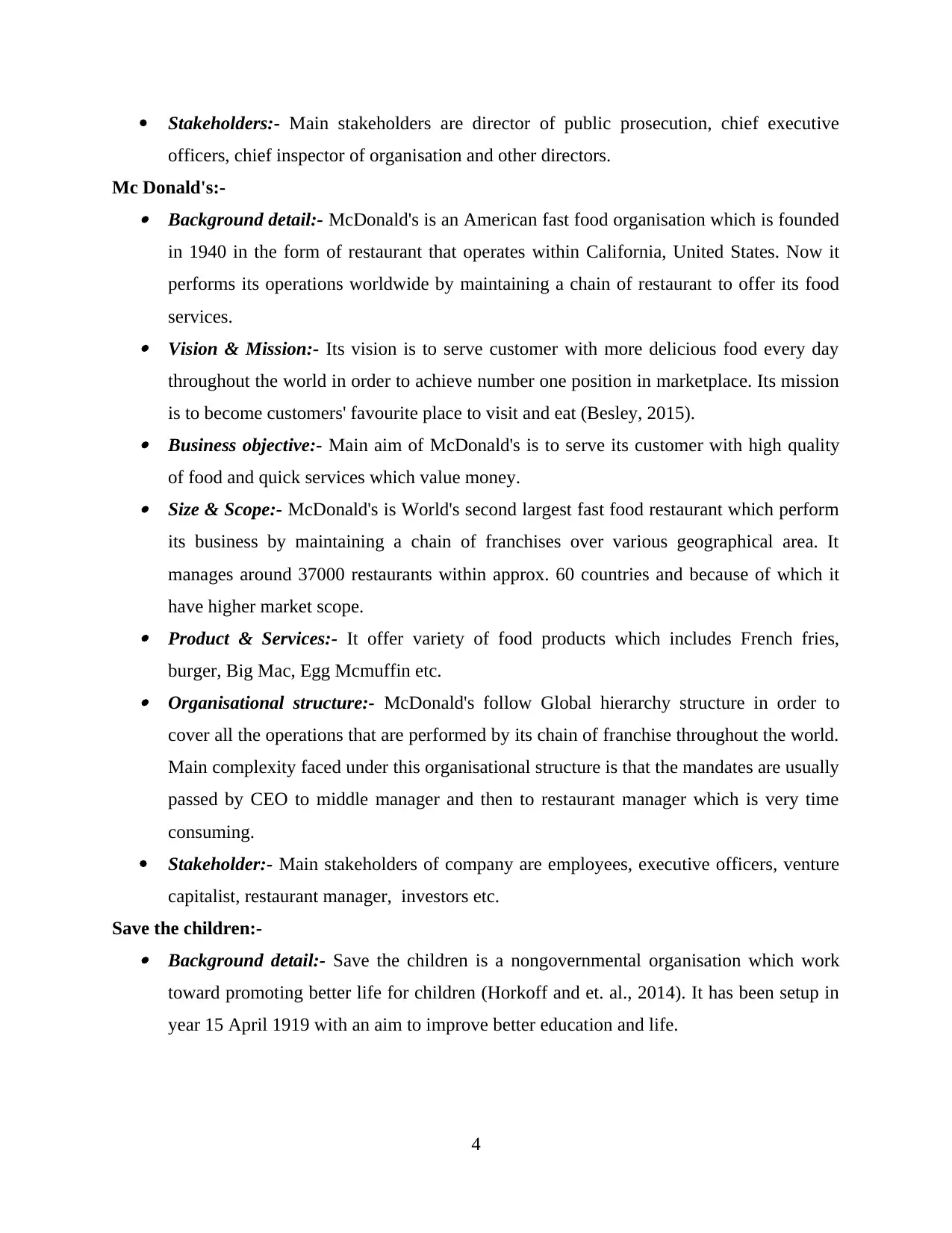
Stakeholders:- Main stakeholders are director of public prosecution, chief executive
officers, chief inspector of organisation and other directors.
Mc Donald's:- Background detail:- McDonald's is an American fast food organisation which is founded
in 1940 in the form of restaurant that operates within California, United States. Now it
performs its operations worldwide by maintaining a chain of restaurant to offer its food
services. Vision & Mission:- Its vision is to serve customer with more delicious food every day
throughout the world in order to achieve number one position in marketplace. Its mission
is to become customers' favourite place to visit and eat (Besley, 2015). Business objective:- Main aim of McDonald's is to serve its customer with high quality
of food and quick services which value money. Size & Scope:- McDonald's is World's second largest fast food restaurant which perform
its business by maintaining a chain of franchises over various geographical area. It
manages around 37000 restaurants within approx. 60 countries and because of which it
have higher market scope. Product & Services:- It offer variety of food products which includes French fries,
burger, Big Mac, Egg Mcmuffin etc. Organisational structure:- McDonald's follow Global hierarchy structure in order to
cover all the operations that are performed by its chain of franchise throughout the world.
Main complexity faced under this organisational structure is that the mandates are usually
passed by CEO to middle manager and then to restaurant manager which is very time
consuming.
Stakeholder:- Main stakeholders of company are employees, executive officers, venture
capitalist, restaurant manager, investors etc.
Save the children:- Background detail:- Save the children is a nongovernmental organisation which work
toward promoting better life for children (Horkoff and et. al., 2014). It has been setup in
year 15 April 1919 with an aim to improve better education and life.
4
officers, chief inspector of organisation and other directors.
Mc Donald's:- Background detail:- McDonald's is an American fast food organisation which is founded
in 1940 in the form of restaurant that operates within California, United States. Now it
performs its operations worldwide by maintaining a chain of restaurant to offer its food
services. Vision & Mission:- Its vision is to serve customer with more delicious food every day
throughout the world in order to achieve number one position in marketplace. Its mission
is to become customers' favourite place to visit and eat (Besley, 2015). Business objective:- Main aim of McDonald's is to serve its customer with high quality
of food and quick services which value money. Size & Scope:- McDonald's is World's second largest fast food restaurant which perform
its business by maintaining a chain of franchises over various geographical area. It
manages around 37000 restaurants within approx. 60 countries and because of which it
have higher market scope. Product & Services:- It offer variety of food products which includes French fries,
burger, Big Mac, Egg Mcmuffin etc. Organisational structure:- McDonald's follow Global hierarchy structure in order to
cover all the operations that are performed by its chain of franchise throughout the world.
Main complexity faced under this organisational structure is that the mandates are usually
passed by CEO to middle manager and then to restaurant manager which is very time
consuming.
Stakeholder:- Main stakeholders of company are employees, executive officers, venture
capitalist, restaurant manager, investors etc.
Save the children:- Background detail:- Save the children is a nongovernmental organisation which work
toward promoting better life for children (Horkoff and et. al., 2014). It has been setup in
year 15 April 1919 with an aim to improve better education and life.
4
⊘ This is a preview!⊘
Do you want full access?
Subscribe today to unlock all pages.

Trusted by 1+ million students worldwide
1 out of 21
Related Documents
Your All-in-One AI-Powered Toolkit for Academic Success.
+13062052269
info@desklib.com
Available 24*7 on WhatsApp / Email
![[object Object]](/_next/static/media/star-bottom.7253800d.svg)
Unlock your academic potential
Copyright © 2020–2025 A2Z Services. All Rights Reserved. Developed and managed by ZUCOL.





